Service model for new hospital
On this page
Frequently asked questions about the service model for replacement of the Belford hospital in Fort William, serving the Lochaber area. Posters of hospital plans.

Frequently asked questions
Questions and answers about the service model (as at 21 November 2025).
Read more about these frequently asked questions (pdf, July 2023).
Service model posters
Printed copies of these service model posters are now available to view at:
- Fort William public library
- Mallaig public library
- Caol public library
- Belford Hospital reception
Illustration plan shown is representative - not finalised.


Lochaber health and social care redesign
-
Lochaber health and social care redesign
Lochaber service change, including the project for replacing Belford Hospital.
-
Service model for new hospital
Frequently asked questions about the service model for replacement of the Belford hospital in Fort William, serving t...
-
Meetings and publications
Meeting minutes and other publications relating to service redesign in Lochaber.
-
News features
News articles and press features around Lochaber service change.
